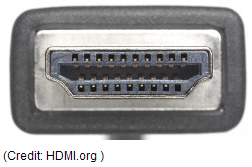
ven though this conversion is weird, it makes it much more likely that the data transmitted can be rebuilt on the other end (as in, at the display).
The second part of TMDS (the DS part) is the HDMI cable itself. Each HDMI cable is actually multiple small, copper wires. Two versions of the data are sent over different wires. One of these is out of phase with the "real" signal. The TV receives all the data, puts the out-of-phase signal back in phase, then compares it to the "real" signal. Any noise picked up along the way will now be out of phase, and as such it is effectively negated and ignored.
If you're an audio person, this is similar to how balanced (XLR) cables work.
TMDS works really well, allowing for short cables and fairly long cables to carry what is a pretty intense amount of data. It also means you can have inexpensive cables that work just as well as expensive ones.
More important to our discussion, it means that when something goes wrong, it goes really wrong. It's often said that with an HDMI signal, you either get everything and it's perfect, or it isn't perfect and you get nothing. In fact, I've said this. If you're getting an image that looks correct, and there are no dropouts in the audio or video, then you're getting everything that's being sent. If the cable is faulty, or it's a really long run with an under-built cable, most of the time you'll just get nothing. No picture at all. |


